Spoiler alert: Game of Thrones season 1-6, some minor A Song of Ice and Fire descriptions
Jumping off from our last long look at Marg Tyrell, we now turn our attention to the little dove of the north, “Sansa Stark”. If you have not already read Kylie’s and Julia’s piece on the season 6 Winterhell plotline, I suggest you do at some point to fully understand my salt with Sansa’s character and, in turn, her fashion design.
To recap a few key definitions:
- Watsonian analysis: looking at the way a costume functions within the universe; how it is explained in the show, and
- Doylist analysis: looking at the reasons a costume came to be as a form of art created by real people; analyzing and critiquing real-world explanations
Keep in mind, too, that we should always ask if a costume functions how it is supposed to. A beautiful costume that fulfills its purpose survives both Watsonian and Doylist analysis better than one that completely misses the mark. Costuming adds or detracts from the credibility and integrity of the overall work, and whether it adds or detracts depends on if it is believable in the context.
So let’s jump right on in to our next section of A Song of Pins and Needles.
The North is Where Fashion Goes to Die
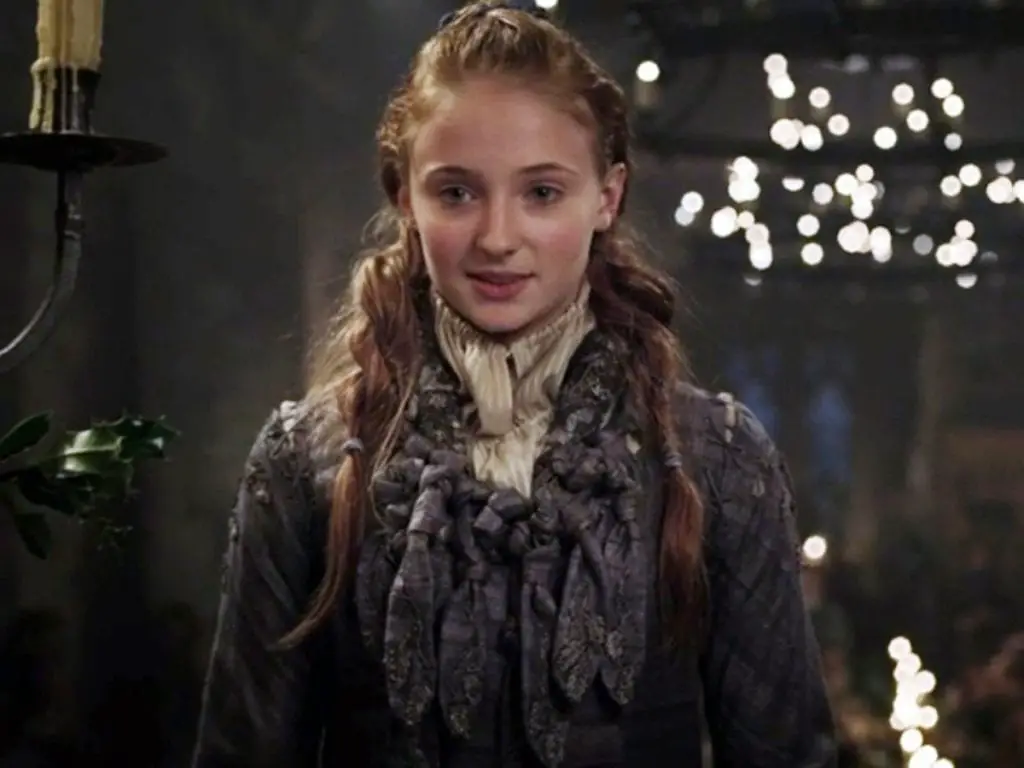
We start off blundering out of the gate, with “Sansa Stark’s” first few bizarre season one dresses. There isn’t anything worthy of analysis here in and of itself – there are just two points I want to note for future reference.
First, Sansa’s feast dress is episode one is ugly. I mean, what is even happening at the neckline? Someone tied knots in fabric and called it a design. Luckily for us this style quickly disappears and, as far as I can tell, never reappears in the remaining seasons. Thank the gods.
The objective ugliness of this dress makes me think Cersei is pulling a little Regina George on us when she compliments it.

Second, Sansa specifically states that she made this dress herself. She is proud of the fact that she created her own garment, and Cersei even suggests Sansa might make a beautiful dress for her – the queen – one day. It is seeded from the start that Sansa is a talented seamstress and embroiderer. This is part of her identity as a northern lady within the show’s cannon. Put this tidbit in your pocket for later.
The Wedding Dress I Want to Love
The first exquisite costume we get on “Sansa Stark” is her wedding dress when she is married to Tyrion Lannister. Before we get into the disappointing analysis, let’s all take a moment to appreciate the fantastic craftsmanship it took to create this gown, including the sewing and embroidery skill.
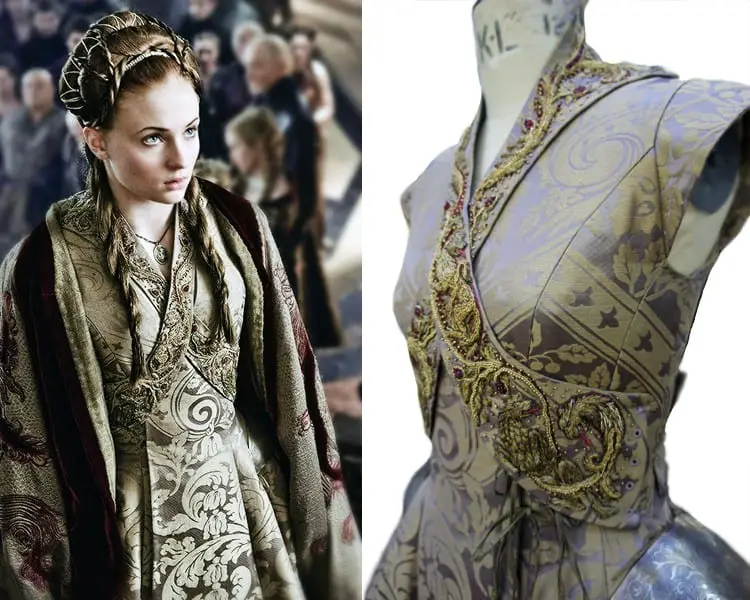
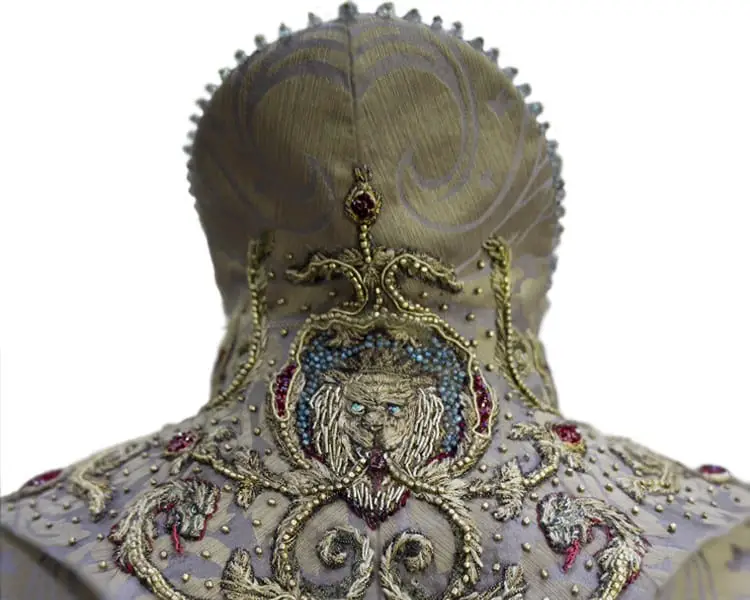
There is no denying this is an exquisite costume. And it doesn’t suffer from Marg-Went-to-Kleinfeld syndrome – that is, Sansa’s gown fits in the time period. I love this dress, but it would be weird for me to wear it as a bride to a modern wedding.
Overall, I think it is successful at what it’s trying to do. The gown is meant to be a very fancy dress for the wedding of some very important people. It doesn’t stick out like a sore thumb, it doesn’t break the suspension of disbelief, and the quality is excellent. This is one of my favorite dresses in the series, and when I first put it on the list to analyze, I thought it’d be a rare moment for us to celebrate Clapton & Co.’s design aesthetic.
But like *almost* everything else on this show, even this beautiful design crumbles under mild scrutiny.
Watsonian “In-verse” analysis: What even are feudal houses anyway?
Sansa Stark’s first wedding dress falls short under Watsonian analysis because of its color and embroidery patterns. It is otherwise the right kind of gown – elegant, extravagant, and chronologically appropriate. But coloration and imagery matter in a society governed by the rule of feudal lords with house colors and sigils. We have multiple examples of people referring to each other as their house sigil, including the Lannisters’ constantly referring to themselves as “lions” and the Starks always being called “wolves”. And lest we ever forget the importance of house sigils as vessels for metaphor, season one gives us two scenes that drive the point home. The first is a book scene used to foreshadow events to come.
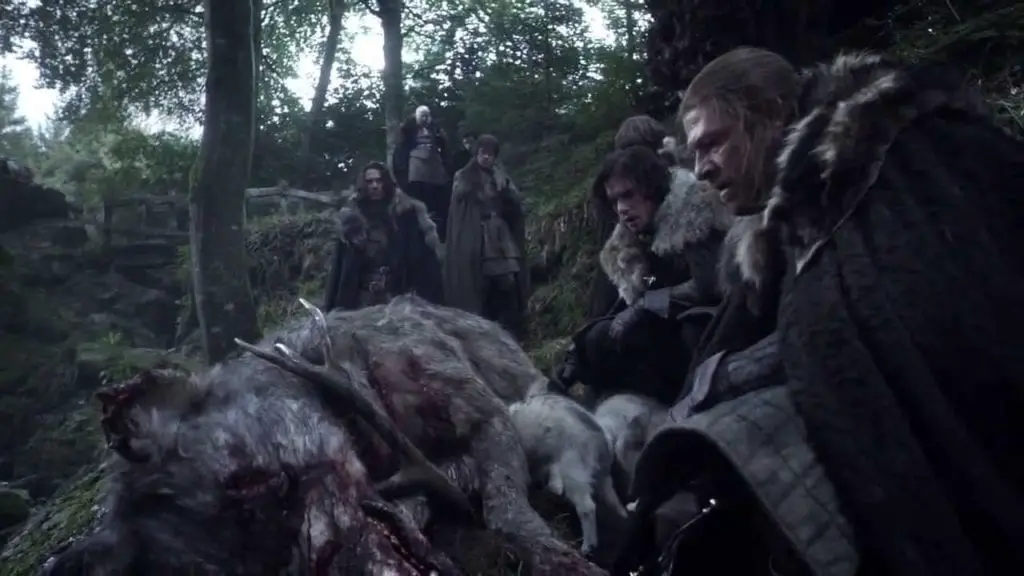
And the second is a show “original” copy/paste of the book’s metaphor.
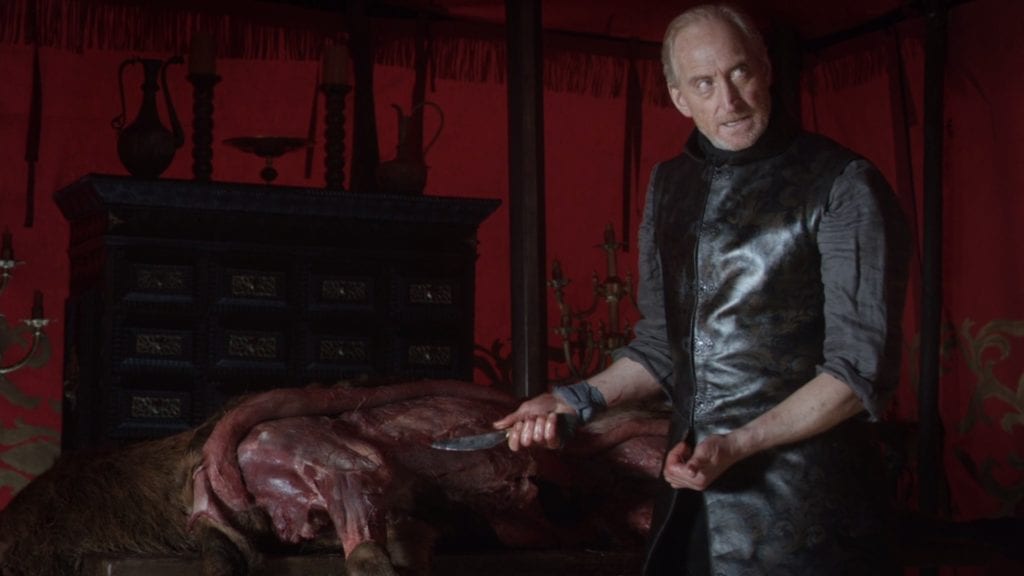
The fact is that color and imagery matter in this society because both are part of the larger PR campaign of each house as the people within vie for power. They are like a team color and a team mascot – something simple everyone can rally around and emulate. More importantly, they let everyone know whose team you’re on. Which is why banners are particularly important in battle, which D&D care about profusely.
The function of color and imagery in the Westerosi wedding context is to show a woman passing from her father’s house to her husband’s house, solidifying her future children’s place as part of her husband’s house. In the context of major marriages – where large, powerful houses are marrying each other – the imagery of both houses is equally important to advertise to joining of great wealth. We see this in the show with Margaery, who wears a distinctly Tyrell wedding dress with (sort of) Tyrell colors and Tyrell imagery, with hand-rolled roses all over the gown. The next function is to show the moving of the woman from one house to another. We see this in the show with the “cloaking” ceremony, wherein the husband places his family’s cloak on the wife. This happens once to Sansa (the northern lords also forgot about the cloaking ceremony, YOLO) and once to Margeary. It is the literal covering of the woman in the husband’s colors, showing the lords, ladies, and small folk alike that she is part of a new team.
The struggle with Sansa’s first wedding dress, then, is two-fold: first, she starts off in her husband’s house colors, even though she is part of a major house; and second, there is only one cloak. Granted, that second problem is true in all the marriages we see, but it is particularly present here because of the dress itself.
Sansa Stark should be wearing the Stark house colors and imagery on her wedding day, period. It does not matter that she’s a prisoner of the Lannisters. She is a Stark, and the Lannisters, in fact, want to emphasize her Stark-ness to solidify their hold on the north through this marriage. As everyone says, Sansa is the key to the north. With her married to a Lannister, the Lannisters take over Winterfell and its accompanying wardenship. It is vital that she is known as and believed to be Sansa Stark. She, therefore, should wear her house colors for the wedding.
For what it’s worth, this isn’t a novel idea. The source material provides the exact description and reasoning for a Stark-colored outfit.
“…the gown itself was ivory samite and cloth-of-silver, and lined with silvery satin. The points of the long dagged sleeves almost touched the ground when she lowered her arms… The bodice was slashed in front almost to her belly, the deep vee covered over with a panel of ornate Myrish lace in dove-grey…”
And a bit later, the maiden’s cloak:
“…a long cloak of white velvet heavy with pearls. A fierce direwolf was embroidered upon it in silver thread. Sansa looked at it with sudden dread. ‘Your father’s colors,’ said Cersei, as they fastened it about her neck with a slender silver chain.” A Storm of Swords
The accompanying issue here is point two: there is only one cloak. The purpose of two cloaks is to drive home the visual to the audience (i.e., the smallfolk and people over whom the powerful marrying couple have power) that the wife’s power is subsumed into the husband’s house. The physical removal of her father’s cloak and replacement with her husband’s cloak symbolizes that transfer of power, which is the whole purpose of a wedding in Westeros.
In Marg’s marriage, while we don’t have two cloaks, we at least get a similar visual because of the colorization: Marg is wearing (sort of) green, and that rose-bedazzled gown is physically covered by the Lannister cloak. Sansa, by contrast, does not give us that visual. Since she already starts out wearing her husband’s colors (gold – and red, if you count her hair), and since she does not have a house Stark cloak, we don’t get the imagery of the Lannisters taking the Stark power for themselves. Without the symbolism for the masses, the entire purpose of the wedding is undercut.
Within the context of show!Westeros, it doesn’t make sense for Sansa to have a wedding dress in her husband’s colors. We know this because of Marg’s dress, which is so thoroughly Tyrell, and even Marg’s second wedding dress which tries to place her as part of the royal family already by being gold. Marg’s position as someone who has a legitimate claim to the queenship based on her marriage to Joffrey was vital to her image and her marriage to Tommen, so it makes sense for her colors to be Baratheon.
The same issues appear with the imagery embroidered onto Sansa’s dress. The embroidery here is amazing, but it is inaccurate. Sansa should be wearing the symbol of her house, just like she should be wearing Stark colors. The embroidery on her dress actually includes the house symbols for the Tullys and the Starks AND the Lannisters! Her bodice is starting to look like Noah’s Ark.
Unfortunately, while this is one of the best quality gowns in the show (that brocade though!), it fails in its basic design. It certainly passes as a wedding dress, but the inconsistency it promotes forces us to continue to the second part of our analysis where we consider the real-life motivations behind the design.
Doylist “real-life” analysis: The Metacademy of the Arts Doesn’t Teach Sigils
Before we continue down the path of perpetual disappointment, we need to take a moment to appreciate the glorious angel who is Michelle Carragher. Much of the fantastic embroidery done on GoT is the product of Michelle Carragher’s incredible talent. If you ever want to experience jaw-dropping beauty somehow crafted from the fingers of a flesh-and-blood human, take a peek at Michelle Carragher’s website and her embroidery achievements. She is an embroidery god among us lowly pretenders, and she does a bang-up job on everything she touches.
It’s not Michelle Carragher’s fault – nor is it Michele Clapton’s – that she must work inside the skewed world created by D&D.
“For Sansa’s wedding dress the designer Michele Clapton wanted to have an embroidered band that wrapped around which symbolistically told Sansa’s life from the Tully and Stark beginnings to the entanglement with the Lannisters,” says Michelle, “The dress colour was still very much Sansa Stark and the embroidery had pale golden tones but woven through the story are ripe red pomegranates, the red colour symbolising the growing Lannister influence over her.” Michelle Carragher
Here, we see the same problem that appeared with Marg’s wardrobe: the meta-seamstresses of Westeros strike again! Based on a previous reader comment, I now assume these are all graduates of the Metacademy of the Arts, located in Volantis on the same campus of the Metacademy of Medicine.
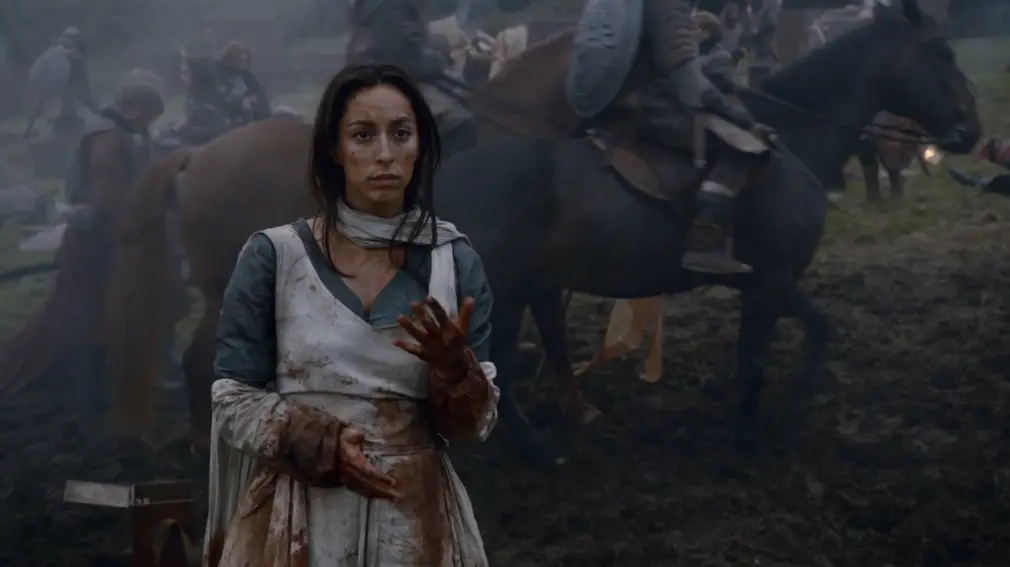
The concept of telling a story through embroidery is cool. There’s an exceptional amount of detail that can go into embroidery that acts like an Easter-egg once the audience realizes it’s there. If done right, this sort of detail adds a lot of depth to the story, and it shows how much the creators care about every little detail. Plot-supportive, detailed but not-so-obvious surprises bolster the credibility of the creators and strengthen the consistency of the story. Consider Nibbler’s shadow in Futurama, or the various prophecies in A Song of Ice and Fire.
But here the embroidered story doesn’t make any sense. Who made this dress?? Is there a seamstress in King’s Landing who decided to include an act of resistance in a very important wedding dress, and nobody else noticed? Certainly none of the Lannisters commissioned the piece to have symbols of Tully fish and Stark wolves being eaten by lions. The whole point of a wedding is the legal passing of power through a woman from one house to the next, not to highlight the murders of her family members (especially murders the Lannisters don’t want to take credit for – the Red Wedding was against the gods). Who embroidered this in-verse?
And this embroidery story wouldn’t even be necessary is Sansa just had the cloak of her house. If you want to show a Stark being overtaken by a Lannister, then have a Lannister remove her house cloak and put his in its place! It’s almost like the source material already has a way to deal with this specific dilemma.
This is a cool idea with no backing. Just like Marg’s wedding dress, Sansa’s was almost well-executed but for enough in-verse believability to hold it up. It is symbolism done poorly. Symbolism should not break continuity, and this certainly does. Tywin Lannister would have blown a gasket if he realized the “symbolism” on his son’s wife’s wedding gown.
What could have made all the difference was the color choice. And here, again I wonder if anyone paid any mind to the source material at all. There was no reason for the costume department to stray into gold for this dress – the book clearly puts her in Stark colors, and the wedding dress would have made sense if it was Stark colors. The only explanation I can think of is that Clapton & Co. did not read the description of Sansa’s dress and just made their own how they chose. This becomes a greater likelihood as we see repeated instances of dresses that do not remotely resemble their book counterparts, like Marg’s wedding dress. There’s really no excuse to avoid the source material. They certainly didn’t improve on the design!
And last, there’s no excuse for these mis-matched patterns at the seams.
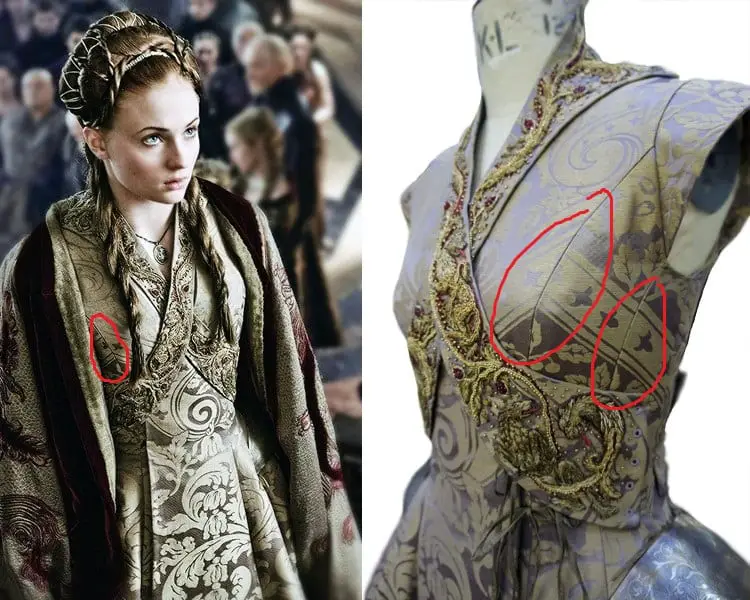
Inconspicuous Me
Before we jump into the Darth Sansa Warlock Costume and drown ourselves in exasperation, let’s take a look at a beautiful and confusing little detail of Sansa’s emo transformation. You may recall Sansa’s dazzlingly beautiful dress she wore to Marg’s wedding.
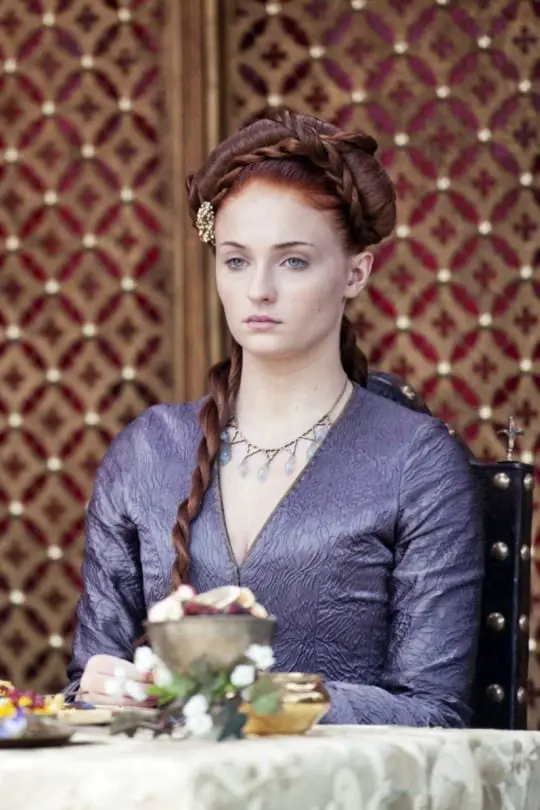
She attended the Purple Wedding wearing purple (woah!) with little firefly clasps on her dress. As a side note, apparently there’s a whole thing about how Sansa’s jewelry is always fireflies and butterflies and shit, because that’s her spirit animal or something. I couldn’t find any direct quotes from Clapton & Co. on this, so I’m going to pray it’s a fan honeypot and leave it there. For the love of the seven, I hope it’s not something she actually said or intended.
Sansa is whisked away to the Eeyrie in this dress, where she later undergoes her emo evolution. One of her black dresses is this one, which appears in the tavern scene as she travels to Winterfell:
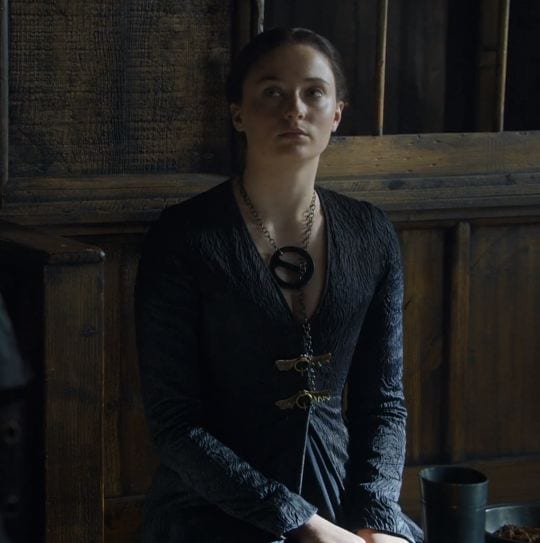
Notice the texture of the fabric, the cut of the bodice, and the firefly pins. You guessed it – this is the exact same dress that Sansa wore to the wedding, only dyed black! I actually don’t hate the idea of Sansa dying an outfit to be able to use it again, and if this were another show with more credibility, I would say this was an good example of a not-so-obvious detail that adds depth and continuity to the story. But this is GoT season five, they’ve lost all benefit of the doubt, and this particular attempt at detail just raises bad questions.
Where did Sansa get enough black dye to re-dye this dress? How multi-functional is this gown? It’s fancy enough for a wedding where she’s sitting at the dais with the king and queen, but also versatile for long-distance travel? Will no one recognize the style of dress, including the fuck-off little dragonfly pins, just because it’s dyed black? I mean, Sansa was literally right in front of a huge crowd of people all day. Also, dying the fabric a new color doesn’t make it less of a fancy fabric – the natural daughter of Petyr Baelish shouldn’t be wearing the same thing as Lady Sansa Stark/Lannister.
In addition to this weird detail, we have Sansa’s not-so-sublte super secret spy outfit. Here she is, not sticking out in a crowd at all:
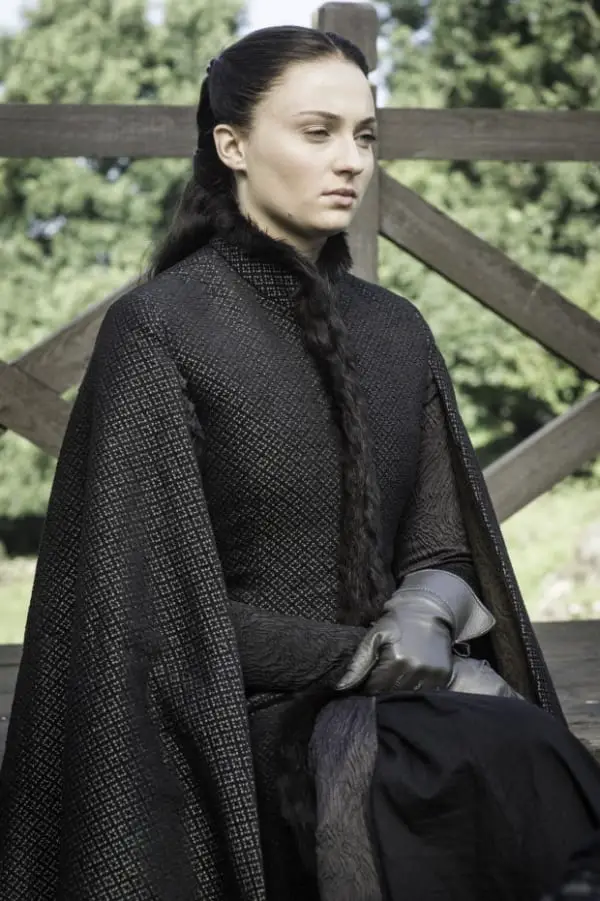
All the common ladies wear this fashion! Wearing all black is normal for people not in the Night’s Watch! Black isn’t an important color for this socety meant for one specific group of people! EVERYTHING IS FINE DON’T LOOK AT ME.
This is not a spy movie. Wearing black does not make her undercover. Wearing black does make her stand out, since black is significant to this culture because of the Night’s Watch. The super secret spy outfit is not fooling anyone. Though I must say it is impeccably tailored.
Sansa Went to Hot Topic
Let’s get to the point: there is an endless amount of bullshittery about the Darth Sansa costume. I don’t find it worthy of Watsonian analysis because there is literally no way to tease out anything intellectually honest about it. This is a modern dress with modern details, sewn with modern techniques (i.e., machines), that was dropped into a medieval setting with no adequate in-world explanation. Where did Sansa get the fabric? How did she have this idea for a design? Why did she think black was appropriate for her disguise? How did she make the dress in such a short time? What is happening???
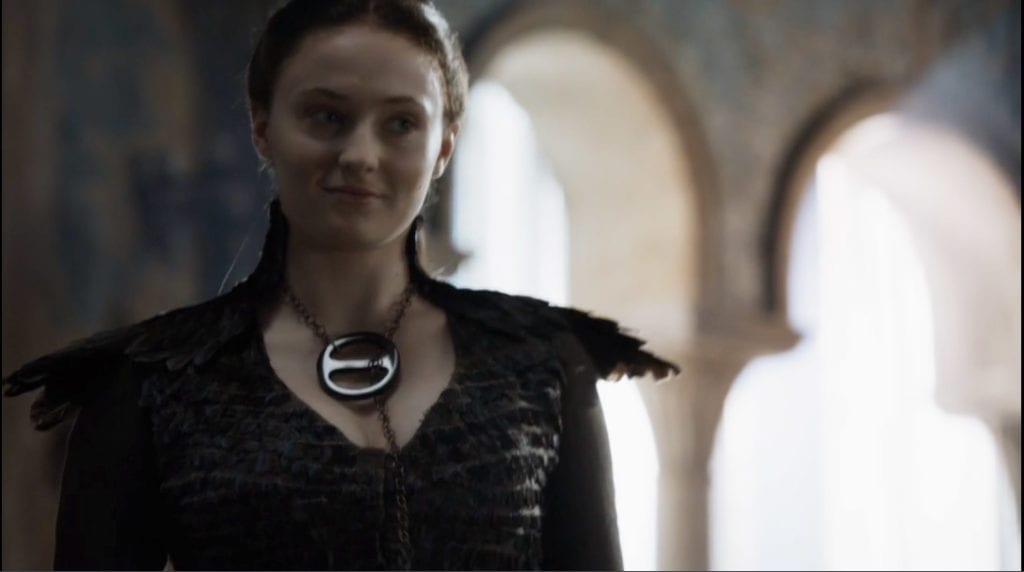
On the flip side, D&D and Clapton & Co. have tried to Doyle this shit up since the moment it appeared on screen. Their motives and explanations make no sense. Studying their explanations through the Doylist lens is where all the meaty analysis is here. Let’s start with the big quote from Michele Clapton:
David and Dan came to me with the idea of a transformation for Sansa. They wanted her to be her own woman rather than this victim. […] It’s meant to be as if she is somewhat reborn while mourning for all that she has lost. We know that she has the skill because we have seen her doing needlework from season one, but I liked the idea that she doesn’t want to sew anymore. The metal piece is really a miniature of Arya’s sword, Needle, and the idea is that there’s a ring that you stitch through and then that’s her weapon. I like that she carries it when she descends the stairs, now she’s armed and it’s a link to her family.
It’s so easy to make someone look strong, but if you don’t think about the story, it’s kind of a wasted gesture. She could have probably looked even more amazing if I had put the reasoned arguments of where it could have come from aside, but ultimately, it makes it a stronger look if it’s a more believable transition. – Michele Clapton
Seven save us, there’s a lot to unpack here. Starting from the top, the first issue is that D&D seem to think costume changes signify character growth. We’ve seen that happen a few times in the show – most notably the emerging of Cheryl from the husk of Carol – and it inherently isn’t a bad idea. When people change, the way they express themselves changes, too. I could buy these costume-changes-with-character-growth claims if and only if there was actual character growth that was (1) earned and (2) followed through on. Sansa gets her badass warlock costume because she’s so badass and her badassness is badass, but it’s followed by her stupid forced marriage and contrived sexual abuse. But she’s strong in the real way now because she has a badass costume change? She’s not going to be a victim anymore, right? D&D’s use of costume changes to signify growth is just disingenuous because the script ruins everything.
It should also be noted that this is around the time the Sansa Stark Construct begins to emerge, which has a direct affect on the explanations given by the creators.
The next issue is this concept that Sansa no longer wants to sew. This idea comes out of nowhere and has no Watsonian explanation. Sansa is an extremely talented seamstress! Remember that tidbit I told you to put in your pocket for later? Well pull it out now, and recall that Sansa has been seeded as an excellent seamstress since the very first episode. Sewing is important in this society because you otherwise would not have any clothes. At all. Being able to make your own clothing is a HUGE asset to yourself and your family. As a highborn lady, Sansa needs to not only be able to sew, but also be able to sew really well to make fancy dresses, which is what she is supposed to wear. This sewing dilemma is part of the strife between Sansa and Arya, as Arya does not fit the mold of a highborn lady because she lacks sewing skills.
Since there’s no reason for Sansa to no longer want to sew, there must be some reason the creators would put that motivation in her head. To me, this seems to be part of the misogynistic and toxically masculine pattern of D&D’s storytelling, even when they don’t realize it. Sewing is a woman’s job in Westerosi society. The counterpart job for men is metalwork, like how Gendry is a smith, making armor. If Sansa is going to be Strong in the D&D way – that is, “strong” with toxically masculine traits – she needs to stop sewing and start carrying a weapon. Hence, we have the notion that she no longer participates in a female activity and instead carries a small version of her sister’s sword with her.
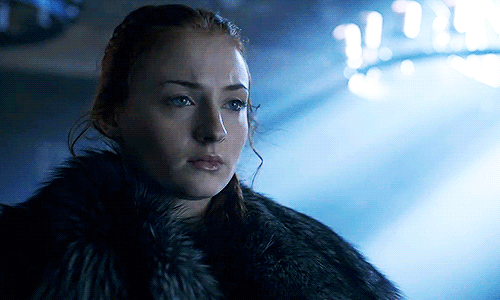
What confuses me (besides literally everything about this) is that they missed the opportunity to actually draw a fulfilling comparison between Sansa and Arya and how they navigate the world. Arya’s sword is called “Needle” in direct defiance of Sansa. As Arya says, “Sansa has her needle, now I’ll have my own.” This sets up a perfect opportunity for parallelism in themes, where each sister deals with the same theme (identity) through different means. By dealing with the same issue of their Stark identity in different settings, the reader/audience gets to see the similarities between the characters and how their identities as Starks largely define them, even when they are worlds apart. This in turn plays into broader themes in the story about birth and the feudal system, and the critique of human nature George R.R. Martin creates.
The show, now being ahead in both Sansa’s and Arya’s stories, had the opportunity to call back to that “needle” dichotomy and hit it home for the audience. Sansa should not be abandoning her needle. She should be using it as a weapon, in the same way she uses her courtesy as armor. Sansa can use her ability to sew to dissemble into the crowd and hide herself; she could’ve used her ability to sew to announce herself at the Eyrie as Sansa Stark, coming out to the lords and ladies in a Stark-themed gown. Outfits make statements when the designer knows what she is doing and has the skill, and Sansa certainly is seeded to have the skill. There are hundreds of options for ways Sansa could use her sewing skills to tease out more agency in her situation.
Instead, we get one last weird feather dress and the concept that Sansa no longer will use one of her greatest skills to her advantage. So much for taking control.
Third, what even is this necklace. This looks like a plastic belt buckle. And what even is the explanation of this necklace:
The metal piece is really a miniature of Arya’s sword, Needle, and the idea is that there’s a ring that you stitch through and then that’s her weapon.
What? Is that a full thought? Is that really what we get? It’s her weapon because it’s a miniature of another weapon, and you stitch it through the necklace, so that’s a weapon! This is a professional adult’s explanation. WHAT ARE WE DOING HERE.
I like that she carries it when she descends the stairs, now she’s armed and it’s a link to her family.
You do realize she’s not actually armed. Like, it’s not an actual sword. She’s not even metaphorically “armed” with it. You know what she could be metaphorically “armed” with? Courtesy and a real fucking sewing needle.
The saddest part is the last bit, where Michele Clapton tries so hard to convince me everything was well thought out.
It’s so easy to make someone look strong, but if you don’t think about the story, it’s kind of a wasted gesture. She could have probably looked even more amazing if I had put the reasoned arguments of where it could have come from aside, but ultimately, it makes it a stronger look if it’s a more believable transition.

There’s a few more upsetting quotes from Clapton trying to explain away her shame.
“We’ve always known that Sansa makes her own clothes, so it was a very deliberate decision of hers, to change and say, ‘I’m not going to be pushed around. I’m going to take charge.’”
There’s the unfortunate implication here that being sexy means a woman is “taking charge”. Sansa’s warlock costume is obviously much sexier than she’s ever appeared, and happened just on the cusp of the actor, Sophie Turner, finally being of legal age. The pattern of women using their sexuality as a form of manipulation, and thus a way to take control, on GoT is alarming, discomforting, and sexist. Michele Clapton’s understanding of this costume fits into that pattern.
Clapton drew our attention to Sansa’s necklace, which has a long spike at the end. Because Arya has her Needle, this is Sansa’s Needle. “It’s her chance to take control,” Clapton said. “When she comes down the stairs, she’s playing with it like, ‘This is me, taking control of this situation.’”
Because fondling a miniature “sword” with no power to actually hurt anyone or actually sew is SO powerful and helps her take SO much control.
There’s also the idea that Sansa used raven’s feather on the bodice and shoulders of this dress. See, ravens send messages, and with this dress, Sansa is sending a message to everyone that she a Strong Woman™! It’s really hard to care about these explanations when they’re this stupid. The feathers are ugly. They look sewn on by a machine and they’re still badly sewn on at that.
Even Myranda isn’t convincing when she compliments this dress.
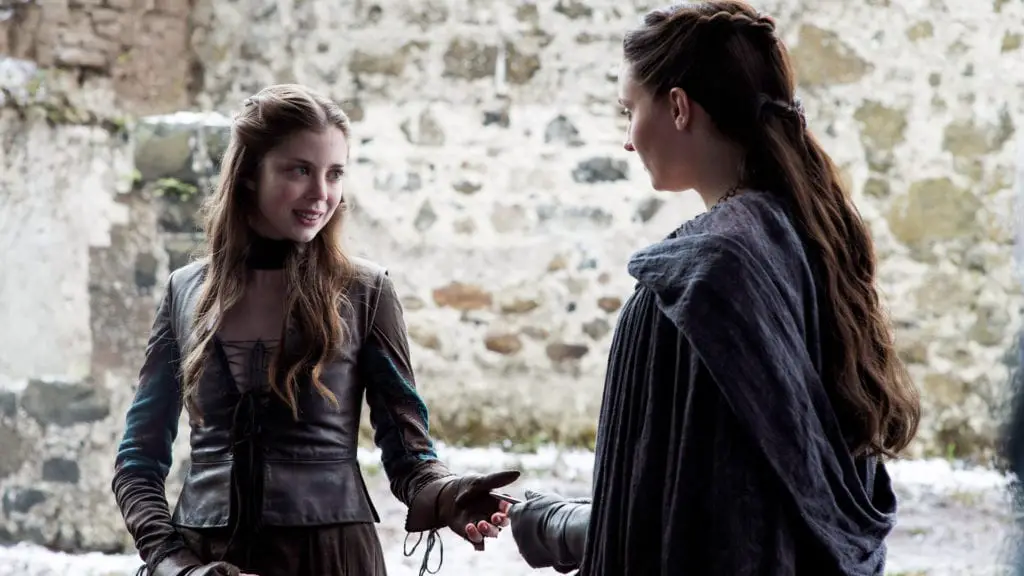
Sansa: Why?
Myranda: I read the script.
Wedding Number Two: Always a Bride, Never a Bridesmaid (trigger warning)
Bowling ahead deeper into season 5, now in the early throws of the Sansa Stark Construct, we get another bizarre costume choice: the linebacker wedding gown. At this point in the show, the Watsonian analysis is basically impossible. I mean, Sansa is marrying into the family that literally killed her own family, for revenge! I can’t really hold the costume department to a higher standard than the fucking story writers.
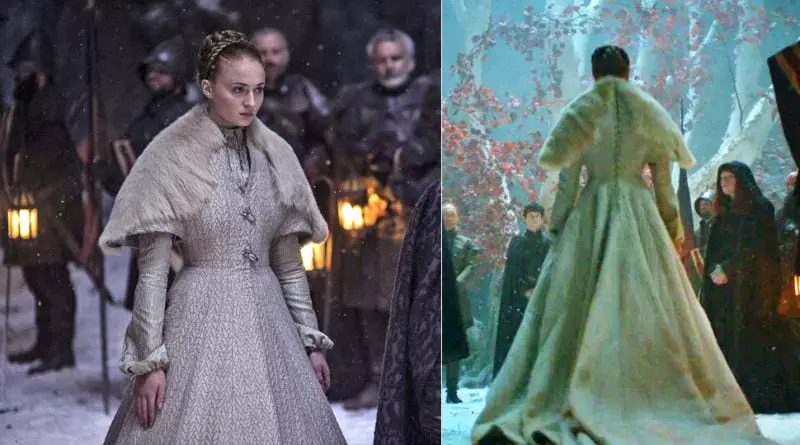
But just to give it a brief moment, here are some problems with the Watsonian explanation of this dress. (1) Color – again, should be Stark colors for the same reasons as above. Note that this dress got closer – white is one of the colors – but there is no doubt in my mind that the designers put her in white to emphasize her virginity for a modern audience (since we put brides in white and associate that with virginity). We know this was the reason because Sansa’s virginity is confirmed multiple times before the wedding scene, with the entire point of making her rape all the worse and more dramatically satisfying. (2) Lack of cloak – same as above. (3) Style and cut – this dress doesn’t look like anything else we’ve seen. Sansa doesn’t live in a world where experimenting with fashion is cool. She certainly had no input on her dress for her forced marriage as a prisoner. And Winterfell doesn’t have any internships for students from the Metacademy of the Arts.
Plus it’s not like Sansa needs to be this covered. The north can’t be that cold with Myranda rockin’ her unlaced corset and fingerless gloves in the exact same scene.
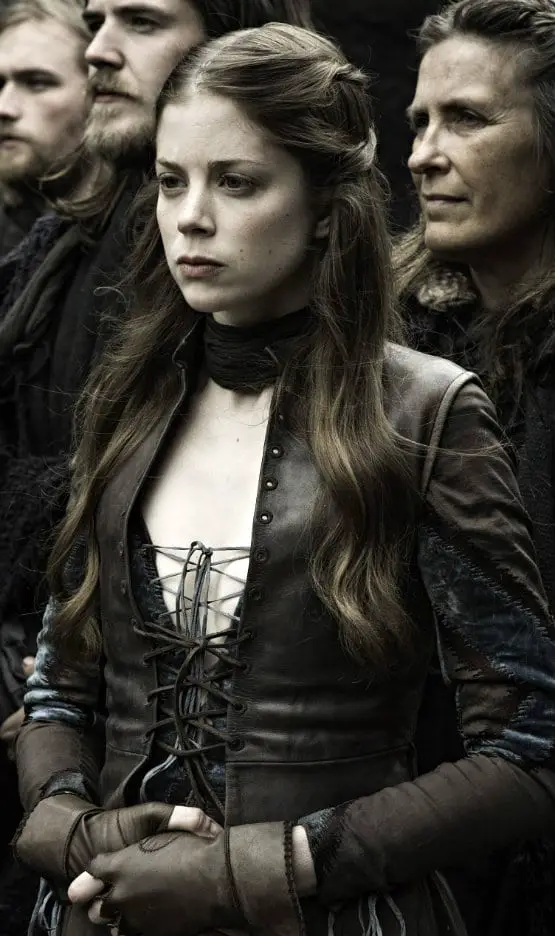
So fuck this Watsonian nonsense – I expended all my honeypotting energy trying to figure out why blue was a Dothraki color. The real meat here, if there is any, is found through the Doylist lens.
Doylist: Everything Comes Back to the Rape
There is no question that the primary driving force behind this creation was Sansa’s impending rape by Ramsay. First and foremost, this is the biggest pattern in the season: that the plot bends head-over-heels to put Sansa in that bedroom with Ramsay. Second, every detail of the costume indicates the purpose of its design. The dress is white. It shows her waist, but is covering her whole body. It isn’t sexy. It has delicate feathers on the shoulder. Sansa’s hair is done in a tight up-do. Everything about it screams “virgin” or “virginal”, to remind the audience that Sansa is “pure” through modern color, shape, covering, and detail.
Michele Clapton said some stupid shit about the dress’s shape being a call back to Sansa’s brother’s and father’s clothes, as a way to honor them or something. It’s another statement by her I’d rather ignore. I mean, don’t all highborn ladies want to look like their fathers’ on their wedding day? And those meta-seamstresses are running out of ideas!
This is a poorly designed, poorly thought-out costume with bad implications. It feeds into the rape-as-drama narrative that ruins this season. On top of all that, it’s an ugly dress. I’ll at least give it this – somebody sewed it. Their skills, however unimportant in this horrid design, are genuinely appreciated.
Conclusion: The Future of the Sansa Stark Construct
I’m not including analysis of the Sansa Stark Construct’s season 6 outfits because (1) I think they will be better analyzed along with her season 7 costumes and (2) none of them are particularly remarkable. We do know that Sansa’a ugly needle necklace is coming back in season 7, and I’m sure I”ll have more to say on the matter at that point.
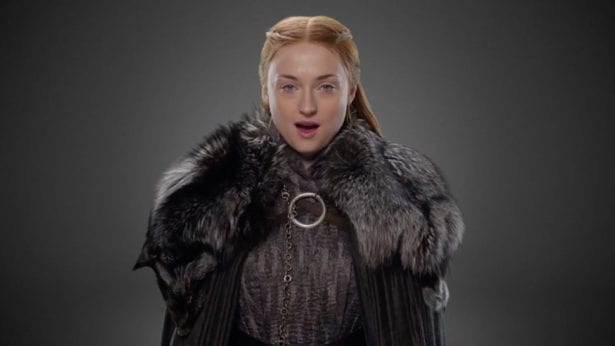
It should be noted that, as Sansa’s personality shifts through seasons five and six, her fashion senses change. She even decides to go back to sewing once she’s at the wall, and she sews at the speed of light! But it’s not surprising, really – I mean, she’s no longer wearing her warlock costume, so now she’s grown as a character back into her previous sewing ways? Because costume changes show character growth? Seeing as the Sansa Stark Construct goes through multiple character changes scene by scene, she is going to become increasingly difficult to dress.
Michele Clapton is back from her brief season 6 hiatus, and D&D consistently give us dramatically satisfying gold, so I expect the costumes to continue on in their predictably disappointing pattern (no pun intended).
Next on A Song of Pins and Needles will be a close look at Cersei Lannister.

